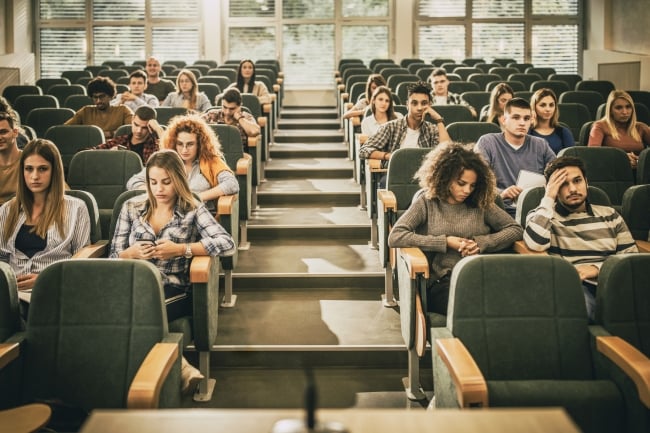You have /5 articles left.
Sign up for a free account or log in.

skynesher/E+/Getty Images
After we discussed morality in a literature class recently, a few students stayed behind to talk about paper topics. One had a question about due dates. Another, in perhaps an unrelated conversation, wanted to talk about the meaning of a film. Yet another had an advisement question. So much of this seemed so familiar, and even pleasantly surprising, because it was the way that I remembered in-person teaching before the pandemic. I was hopeful that this was, at some point, how it would be again.
In such moments of classroom normalcy, I could almost believe that things were going back to what they were because we were back—back in those physical rooms, as Lin-Manuel Miranda might put it, “where it happens,” where instructors have those discussions and conversations with students that may well be the very best part of the job. Quite often, those exchanges are the source of those so-called teachable moments, when a student asks a question that turns a lesson plan on its head and/or is the source of some controversy for the rest of the class. While students can and do make those kinds of contributions in online courses, something is especially compelling about the live reactions and responses in a face-to-face class, something that was not a part of the learning experience for so many during the pandemic.
I sometimes still find it hard to believe that my students and I were in masks during those days, trying to make sense of one another through muffled questions and responses. Visual cues and facial expressions were always missing from the conversation. Even breathing through or into my mask was an adjustment that I hadn’t counted on, and, every now and then, I needed to take an extra breath after an extended comment before I could move on. But once the mandates were lifted, I could almost believe at times that all of it—the quick pivot to remote learning, the snug fit on some of those KN95s, the vaccination lines, the testing protocols—was just a bad dream brought on by too much pizza and a late-night sci-fi flick.
But something was different. The students seemed quieter than usual, or the quiet seemed different to me. My questions hung in the air a little longer, like so many funky, slow-motion baseball pitches, and the students seemed less inclined to take a swing at them. Maybe I was out of practice with being in the room. Maybe they were, too. Maybe I needed to get used to the sound of silence. (Hello, darkness, my old friend.) Or maybe I just needed to change up my lessons in some other way or incorporate some new method that jibed more with how they now wanted to learn.
Although I was quick to think about so much of this as my problem or my inability to get those conversations going, I soon learned that my colleagues were dealing with the same or similar issues. During a virtual workshop with Jeanie Tietjen, from Massachusetts Bay Community College and the Institute for Trauma, Adversity and Resilience in Higher Education, some of my colleagues described a noticeable lack of affect in the students, those same stretches of classroom silence and a general resistance to participate—the telltale signs, Tietjen told us, of traumatized brains and an overloaded, overwhelmed student body. Apparently, the lack of discussion in classes had everybody talking.
As we continue to assess our experience of the return to campuses, we are still examining how the pandemic has impacted students over the long haul—how, for example, engagement in the classroom immediately plummeted and even today remains in question. Over the past months, a number of articles and podcasts have referred to an usual level of disconnection among students, including Jonathan Malesic, who noted in a New York Times essay that a third of his students “were missing nearly every time, and usually not the same third.” Recently, a blog post from Boise State’s Center for Teaching and Learning described ongoing discussions about “lacking student attention, reduced attention span, less interaction and flaky attendance.” These reports speak to the disturbing reality of what we could still be facing for several semesters, even years, to come.
The fact is, for just about all our students, those months of remote instruction, with whatever drawbacks they had, are now a part of their educational DNA. We may have all had underprepared students, distracted students or quiet classrooms in the past. Moving forward, we will probably wonder how much of that is on them or us and how much is still a remnant of their time in quarantine.
If we are all a part of this COVID generation, will we just have to bear down and teach through the silence, until some hardier, more pliable wave of teachers and students succeeds us? Is the most enduring part of the pandemic not something biological, but something psychological, something literally homegrown from our attempts to isolate and stay safe?
Although the problems of a quiet class may not “amount,” as Bogart put it in Casablanca, “to a hill of beans in this crazy world” for many people, that hill could get significantly larger when you think about those students as friends, family members, workers, local community members and even part of a national or global communities. Where the inability to talk to an instructor or a fellow student about the meaning of a Robert Frost poem may not seem like much to some, what happens when that same lack translates to a family crisis or a job conflict? As our students increasingly ignore or dismiss those opportunities to develop their voices and express their ideas, what solutions, innovations, critiques and concerns will now be left unsaid? What frustrations, resentments and grievances will now fester in those weighted moments of silence? What kinds of people will we be graduating, and what kind of world will we and they be creating?
While some surveys have found that “a majority of Americans” now believe that “online education is the same as or better than in-person education,” other contradictory polls have found that “most teen students prefer in-person learning to [online] options.” Meanwhile, we also regularly see studies and stories about the student isolation, depression, anxiety and academic difficulty that resulted from the switch to online learning during the pandemic and how online students continue to struggle with mental health issues.
Malesic is steadfast in his belief that we need a nationwide or perhaps even universal commitment “to in-person classes and high expectations for” our students. And although I am not so sure that institutions will ever abandon online instruction for the “greater good” of on-campus teaching—so many students have come to rely on the flexibility of those courses, just as so many colleges must appreciate them as a source of enrollment and revenue—I do agree with what he says about the larger benefits of being in person.
Spoken Dialogues
In thinking about our jobs as instructors now, I have to say that we serve an even larger and more important purpose than before in bringing both the students and, perhaps, even our communities back from these pandemic years. While we may have been here—or may have thought that we were—to teach students about our disciplines and that was pretty much it, this experience has shown us that we have more to offer than calculus or the Council of Trent or The Count of Monte Cristo alone, as valuable as those things are.
Indeed, if our students are struggling to re-engage with our classes and their peers, perhaps a good part of what we are doing now is getting them to reconnect and see themselves within and as a part of larger conversations—about disciplines, about communities, about cultures, about governments, about the world. Where they may have been more than happy to be passive learners in a Zoom gallery full of tiny faces, our challenge is to bring them back into that active classroom dialogue that has long been a source of intellectual stimulation and educational achievement.
As he made his way through the streets of Athens in search of debates about the meaning of life, Socrates specifically saw verbal conversation as the road to what Blake, in a different context, would later call “the palace of wisdom.” Biographer Luis E. Navia reminds us that the famous philosopher openly valued “the spoken dialogue,” as opposed to the written one, in contemplating that meaning and in having those debates because “the language of actual and spoken conversation” was, for Socrates, “a living reality.” And, in that reality and “those principles,” as he describes them in Plato’s Phaedrus, “of justice and goodness and nobility taught and communicated orally for the sake of instruction and graven in the soul,” we can essentially find the origins of the Socratic method that continues to have an impact on what teachers do in the classroom and to play a part, whether acknowledged or not, in how they organize their lesson plans. Though so much has changed since 400 BCE, perhaps we all still need a good dose of the “living reality” right now that can only be found in our in-person classrooms, where instructors and students can better engage in such “spoken dialogues” in search of understanding.
The road back to those conversations and that wisdom will undoubtedly require more from us, especially as we work against the anxieties, the distractions and the resistance that students now bring to their in-person seats. Thankfully, we have many resources to guide us, from our colleagues, who face the same challenges, to the existing literature on teaching and class discussion. James Lang’s books Small Teaching: Everyday Lessons From the Science of Learning and Distracted: Why Students Can’t Focus and What You Can Do About It could be good places to start, as could Jay R. Howard’s book Discussion in the College Classroom: Getting Your Students Engaged and Participating in Person and Online. Steven Mintz also offers some advice about re-engaging students after the pandemic in this Inside Higher Ed piece.
The changes don’t have to be dramatic and syllabus-shattering. As Lang notes in Small Teaching, even “small and incremental approaches can have great power,” and one or two small adjustments to your teaching could send a message that students might respond to. Something as simple as just getting to class early and talking with students before the lesson begins could be enough to get a dialogue going. Now that they’ve found their way back to our rooms, we need to help them find their way back to their voices.
We do seem to be at some kind of crossroads for higher education, as we try to weigh our sense of what we think is right for our students against what our students say they want against the financial needs of our institutions. While we obviously would like all those things to be in sync, that isn’t always the case—and they certainly do appear to be more in conflict as of late. I cannot overemphasize just how important our decisions will be in these next few years or how impactful the consequences will be for our students and what they do in life. Like Socrates or, for that matter, Indiana Jones in The Last Crusade, we need to be ever so careful about which cup we choose to drink from and ever so mindful about the vital choices we now make about the future of class discussion.




